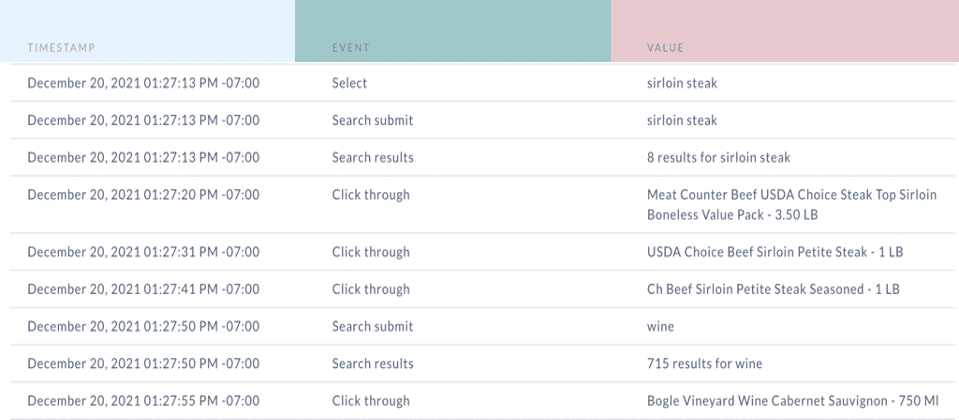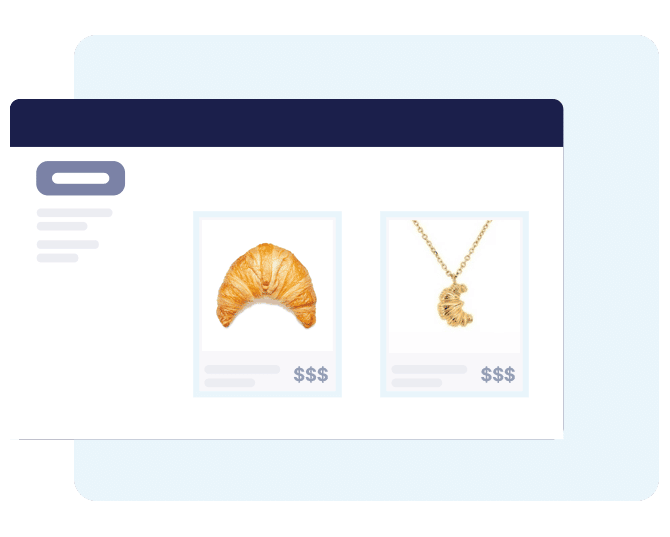Personalization is one of the most common strategies for maximizing revenue from recurring customers. And for a good reason—close to 100% of consumers are more likely to buy from a brand that offers personalization over one that doesn’t.
Most personalization strategies, like creating campaigns based on a customer’s purchase history, are only scratching the surface of what’s possible. Today’s consumers expect more than a promotional mailer for a product they bought within the past six months. True personalization goes much deeper.
In addition to demographics and purchase history data, what if you had full insight into every single customer’s site journey—where they landed, what they clicked on, what they searched for, and where they exited?
Ecommerce clickstream data can help you paint a fuller picture of how customers interact with your site. And from there, you can make smarter decisions about how to merchandise your products and grow your revenue.
In this guide, we’ll explain what clickstream data is, the main advantages of collecting it and using it, and how you can start capturing it to create more personalized experiences on your ecommerce site.
What is Clickstream Data
Clickstream data, at its core, is the trail of your customers’ activity on your website. Each customer enters your site on a certain page and takes a series of actions from there before they inevitably leave. Every time they click on an item, visit a page, or take any sort of conversion-oriented actions, it gets recorded and stored in the clickstream.
Here is a visual example of what this looks like for a single user on a grocery website:

Clickstream data is also sometimes referred to as click path data or clickstream analytics. These terms are used interchangeably.
What Does Clickstream Data Uncover?
Clickstream data can be used to discover a wide variety of important information, including but not limited to:
- The search terms customers use to find your site. Not every visitor comes via search engine, but for the ones that do, you can find out what they were looking to find as well as gauge how well your site is optimized for certain keywords.
- Which pages they visit first. First impressions are important, so therefore, the point of entry is crucial. By pinpointing the most popular entry points to your site, you can fine tune your customer experience to make it as seamless as possible.
- What visitors click on. Knowing what your visitors clicked on will give you so much insight as to what’s enticing vs. what’s not. You’ll be able to answer questions like: what were they most curious about? By knowing what caught their interest or attention, you can also theorize why.
- How much time they spend on a certain page. Your site likely contains a mix of short and long pages. Clickstream data can help you compare your expectations to reality: are people leaving before they should? Are people spending long amounts of time on a product description page? These insights can help you craft a better user experience.
- Which items they browse. You already know what’s selling and what’s not. Are your best sellers also your most clicked items? Which products are people clicking on but not buying?
- Which items they add to or remove from their shopping cart. We’ve all clicked on “add to cart” only to remove that same item later on. Uncovering this type of data can help you figure out which items would make the best candidates for upsell or cross sell opportunities.
Benefits of Using Clickstream Data
Clickstream data presents huge opportunities for your business. In addition to creating a better shopping experience for customers, this data can optimize your ecommerce team’s productivity levels and sales numbers. And because it’s your data on your site, it allows you to stay compliant with global data privacy laws.
1. Make your personalization efforts both better and faster
Most forms of personalization are really just forms of segmentation. Splitting your existing customer base into different categories to send targeted messages allows you to get a little more personal, but doesn’t allow you to create a dynamic shopping experience for each individual.
Machine learning, in contrast, is able to provide true personalization. Customers will see the products that are the most appealing to them when they’re browsing your site—pushing them closer to the point of purchase.
Real-time clickstream data delivers faster results than other forms of personalization, which rely on slower technologies like third-party data and retargeting. Clickstream data can be used to create a personalized shopping experience as early as the first or second session.
2. Save your merchandising team time and effort
Curating product pages and building synonym sets is very tedious, and identifying and implementing improvements can take even longer. Repetitive tasks can be hugely detrimental to your team’s overall productivity.
Product discovery that relies on clickstream data greatly reduces the amount of time merchandising teams spend on manual tasks. The benefit is that your team can can work on other high-priority projects and brainstorm creative optimizations. Even though a product discovery platform might be AI-powered, it can only supplement the level of expertise and creativity your team brings to the table. Clickstream data allows your platform to take care of the grunt work so that your merchandisers can use their knowledge more effectively.
3. Increase revenue per visitor and conversion rates
Clickstream data can help you fine tune your product and landing pages to drive more conversions. For instance, if your clickstream data reveals that a large portion of visitors are reformulating their searches for a certain query, that’s a sign that something needs to be improved. (Thankfully, machine learning adapts to patterns in user search behavior to provide better results over time.)
Similarly, if clickstream data reveals that customers are removing certain items from their carts, you could bundle them with related items to increase your average order value.
These are just two out of hundreds of ways clickstream data can increase your site’s revenue. Coupling it with other personal data you’ve collected and stored will enable you to create hyper-personalized experiences that boost your bottom line.
4. Get personal data without violating privacy policies or other regulations
Thanks to an onslaught of privacy-related scandals, customers are more wary of data collection and what happens if it gets into the wrong hands. At the same time, data privacy laws are also becoming more stringent and widespread. Gartner predicts that 65% of the global population will be protected by one or more data privacy laws by 2023.
As privacy policies evolve, so should your marketing practices. Thankfully, clickstream data remains relatively future-proof in this regard. Clickstream data collection does not violate even the strictest of privacy policies or regulations imposed by third-party cookies.
That’s because clickstream data on your site is first-party data, which means it comes directly from your site visitors instead of being transferred or transformed by third parties. Anyone can visit your website and engage without giving out their personal details. And as the sole owner of clickstream data, you can protect it and make sure it’s stored and used in accordance with all legal guidelines.

Clickstream Data and AI in Ecommerce
Clickstream data analysis is AI-powered, but not all AI-based ecommerce tools use clickstream data. AI simplifies the near-impossible task of layering your business KPIs on top of personalized search results. This allows your team to get far more advanced with personalization efforts. For example, you could display more attractive search results based on each customer’s affinities but rank them according to the KPI you’re trying to optimize for (such as revenue, profit margin, or inventory rebalancing).
No matter which KPI you choose to base your strategy around, clickstream data can directly raise your conversion rate, AOV, and RPV. Large retailers like Rugs Direct and Princess Auto have seen between 14% and 16% lifts in AOV from baking clickstream data into their merchandising plans.
How to collect and use clickstream data

The amount of clickstream data coming through the average ecommerce retailer’s site is enormous. Platforms like Constructor can do what humans can’t: use machine learning to personalize your shoppers’ experiences in real time. Once configured, Constructor can use your clickstream data to optimize product search, browse, and recommendations.
Constructor also uses clickstream data in real-time to recommend products based on affinity rather than keywords. For example, if you were to search “croissant” on a general retailer’s website, you’d probably expect croissants to appear at the top of the results page. However, with a keyword-based algorithm, you may see something like croissant-shaped earrings appear in the results instead, even though that’s not what most people intend to buy. Clickstream data provides more information about actual customer affinity. Constructor analyzes that data in real time to provide better search results and a more personalized customer experience.
The Bottom Line
Clickstream data can be extremely powerful when you use it to your advantage. With the right tools in place, you’ll see your AOV and conversion rates climb as you give your customers a better shopping experience.
We know collecting and making sense of data can be labor-intensive. Constructor can do the heavy lifting for you. Learn more about how Constructor collects ecommerce clickstream data in real time to personalize your customer experience sitewide.

